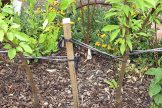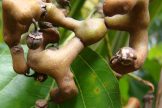
 Important note about plant availability. Important note about plant availability.There are hundreds of factsheets on our website provided for your information. Not all plants will be available at all times throughout the year. To confirm availability please call (03) 8850 3030 and ask for the nursery. |
Choose an open, sunny area in your garden for your olive tree. Olives are not particularly tall but they tend to be broad and have a large root system. The narrow shady space between the house and the fence is not the place for your olive tree, nor is to the south of a large house or fence. A mature olive tree can make a lovely shade tree to sit under particularly on a hot summer’s day. Make sure the tree will receive at least 6 hours of full sun a day all year round. High humidity particularly in summer will promote fungal diseases, so choose an open spot with plenty of air circulation.
Soil
Olives will grow well in a wide range of soils, as long as the drainage is good. Soil preparation is usually digging a wide hole, (at least twice the width of the root ball), and breaking up the soil. Check the drainage by filling the hole with water (it should drain away in half an hour). If the drainage is poor, then dig over a larger area and mound the soil up, then plant at the top of the mound. It is not necessary to fertilise the tree when planting. Plant the tree with the soil at the same level as it was in the pot. Water in well and mulch with a 7cm layer of mulch, making sure the mulch is not touching the trunk.
Watering
Whilst olives are drought tolerant plants, and will survive without much summer irrigation, they will grow and produce more fruit if adequate water is supplied. Olives are Mediterranean plants and therefore prefer cool wet winters and hot dry summer conditions. It is important to receive adequate moisture especially when the trees are forming flowers until the fruit has set on the tree. This is generally late winter and spring. A lack of water at this stage can cause poor flowering, poor fruit set and the developing fruit to be aborted. Of course olives will not tolerate water logging, resulting in die back and death of the tree if prolonged. Newly planted trees will need watering until they are established, being particularly careful during their first summer. Some varieties are also more drought tolerant than others, with some performing well with additional summer irrigation.
Fertilising
Olives do not need a particularly nutrient rich soil, but a little additional fertiliser once a year early in spring will boost the production of your olive. Use a fruit and citrus fertiliser or chicken manure. Do not use high nitrogen fertilisers as these can make the tree more susceptible to a fungal disease called soft nose which spoils the fruit.
Pruning
Most olive trees will not require pruning, however some vigorous varieties may need pruning to reduce their overall size. If you want your tree to produce the maximum amount of olives and still be able to reach them easily then prune down the height of the tree and remove branches to open up the canopy of the tree letting in plenty of air and light. Most olives are much broader than they are tall, that is they have a spreading canopy.
Pests, diseases and environmental stresses
As long as your olive is growing in the correct conditions, then they will remain productive and healthy with very few pest and disease problems. One of the most common pests on olives are scale. These are small sap sucking insects that produce a protective waxy covering under which they feed. They may be pale yellow, brown, black or white and the coverings may be flat and round or raised and irregular. The treatment is the same, spray with White Oil or Eco Oil. The other main disease in the local area is Peacock Spot, a fungal disease which starts as a dark spot surrounded by yellow rings around the spot in winter. Leaves may turn yellow and drop, or may persist into summer where the layers of the leaf delaminate turn white and dry out. The fallen leaves harbour spores which are the source of infection next winter. Spray with Copper Oxychloride in winter and clean up any infected leaves from the base of the tree.
Leaf scorching, particularly at the tip is most likely indicative of over fertilising and lack of adequate water.
Another fungal disease is called Soft Nose and causes rotting of the tip end (the nose) of the fruit. It is caused by excessive application of nitrogen as fertiliser.
Tiny yellow speckling on the upper surface of the leaf may be caused by Olive Lace Bug, which feed on the underside of the leaves. Generally the infestation is not severe and the tree will still remain productive. Olives often produce good crops in alternate years, that is a bumper crop one year and a light crop the following year. Certain varieties will favour this type of production more than others. Some people thin the crop to reduce this effect by tapping the branches with a stick to knock off some of the fruit as it develops.
Harvesting
Olives are harvested at different stages depending on the end use. For green table olives pick the olives as they change from green to yellow – green. For coloured olives pick them just as the first patch of red or black starts to show. Black olives are generally Kalamatas which are picked just as they develop the black colour. If the olives turn black and ripen on the tree then they can be used for oil. Olive fruit can bruise if handled roughly, so if harvesting for table olives pick them by hand rather than knocking them off with a stick.
Weed Control
Olives self seed readily and the seed is dispersed far and wide by birds, thereby creating a weed problem as the trees are very tough and quite happy in our Mediterranean like climate. To reduce the weed potential of your olive make sure you harvest all the fruit every year. Clean up any fallen ripe fruit off the ground and get the olives off the tree as quickly as possible.
Varieties
The varieties on the following list may not all be available at all times. Seasonal and supplier variations mean we cannot stock all of the following, but we do try to keep as many as possible in stock. Drop in or call our nursery staff for more information on (03) 8850 3030.
Barouni – Also known as Uovo di Piccione. Large table fruit (~7g).Suits warm to cold climates. Cold tolerant. Medium yields. Ripens mid/ late season. Usually pickled green. Small spreading tree suited for hand picking. Origin: Tunisia.
Correggiola – Small / medium fruit (2-3g). High yields. Ripens late season. High oil content. Suggested cross-pollinators are Leccino, Coratina, Pendulino. Origin: Tuscany, Italy.
Coratina – Medium fruit (2-3.5g). Bears young and has consistently high yields. High oil content and a very high quality oil, intensely fruity and pungent. Ripens late season. Considered dual purpose. Very cold resistant. Tree adapts well to different growing conditions. Usually pickled green. Origin: Apulia, Italy.
Flemings Jumbo The largest olive on the market according to Greg Fleming. A kalamata style olive. Good bearing tree growing well in hot climates. Good oil content. The leaves are larger than most olives and the fruit is very attractive, a good produce and ornamental tree.
Frantoio (Paragon) -Small / medium fruit (2-3g). Vigorous heavy mid season cropper. High oil content or exceptional quality. The oil is highly aromatic with a pleasant fruity flavour. Pickled fruit have a tasty nutty flavour. Can be processed as Ligurian olives. Compatible pollinator for a range of varieties. Suggested cross-pollinators are Leccino, Coratina and Pendulino. Origin: Tuscany, Italy. The tree is cold sensitive.
Jumbo Kalamata (Grafted Tree) – Very large table fruit (~12g) with a small seed. Impressive fruit size but flesh can be tough and fibrous if not processed correctly. Not related to the true Kalamata variety. Usually pickled green. Origin is unknown but the fruit is similar in form to the Italian variety Oliva di Cerignola.
Kalamata (Grafted Tree) – A very difficult variety to propagate and is thus generally grafted in order to succeed. Medium/ large fruit. Dual purpose. Medium/high oil content. Good quality oil. Pickled black. Highly regarded fruit for processing. Suggested cross-pollinators are Frantoio and Koroneiki. Origin: Greece. Moderately cold resistant and can be affected by extreme heat. Tree can also be sensitive to acidic soils.
Leccino – Small-medium sized fruit. Considered dual purpose. Medium to high oil content. The oil is superbly balanced and palatable fresh off the press with out the harsh bitterness associated with some oils. Highly productive early cropper. The hardy tree resists low temperatures, wind, fog, olive knot, and fungals, especially peacock spot. Foliage is silver green, leaf size is medium small. The trees growth habit is upright. Has low quality pollen so must have cross-pollination to ensure fruit set. Yields may reduce with extreme heat conditions.
Manzanillo – Medium fruit with good flesh to pit ratio. Consistent high yields on alternate years. Ripens early. Exceptionally highly regarded pickling fruit. Pickled green or black. Fruit is of excellent taste and texture. Fruit should be processed before it is fully ripe to retain flesh firmness. Better with cross pollination. Suggested cross-pollinators are Sevillano, Frantoio, Picual and Arbequina. Origin:Spain. Sensitive to cold.
Nab Tamri – Large table fruit. Very good flesh to pit ratio. Regular moderate to heavy crops. Pickled both green and black. Originates from Northern Africa
Picual (Marteno, Nevadillo) – Medium sized fruit (3-4g). Early start to bearing. High yields. During the first years, fruits tend to be larger than normal and they are highly rated for pickling as black olives for the firmness of their flesh.High oil content, oil stands out for its great stability and high oleic acid content. Ripens Mid/late season. Picual is largely self- fertile but can benefit from cross-pollination. Suggested cross-pollinators are Arbequina and Hojiblanca. Picual is used as a pollinator for Barnea. Picual is tolerant to cold, salinity and wet soils. Origin: Spain.
Sevillano (Spanish Queen) Large sized pickling fruit with good flesh to pit ratio. Medium crops. Pick fruit before the first frosts but the tree is very cold resistant.
South Australian Verdale – Medium/Large oval shaped fruit. Dual purpose. Low/Medium oil content, but high quality oil. Inclined to alternate cropping years, but the ‘on’ years are heavy. Flavour and texture of pickled fruit is very good. Easy to harvest.
UC13A6 (Californian Queen) – Very large almost round table fruit with an excellent flesh to pit ratio. Regular heavy bearer. Ripens early/mid season. Pickled green or black. Origin: University of California, USA.





